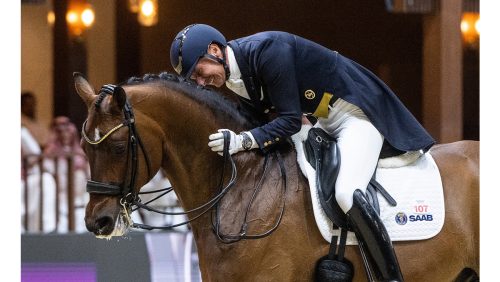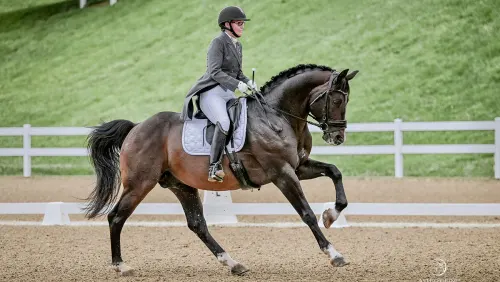For the third year in a row, the Adequan USDF Annual Convention, held Dec. 3-7 in Cambridge, Mass., boasted record short meetings. But there was still plenty of discussion about the organization’s past—the USDF instructor certification program celebrated its 25th anniversary this year—and about its future—how to continue drawing new dressage fans.
“We continue to be on firm ground financially,” said USDF President George Williams. “Over the last two years, the lifetime horse registration numbers have increased. The number of FEI-level rides continues to reach new highs. However, the number of rides at the national levels still is not at 2008 levels. While percentage of membership of GMOS is at 73 percent, we have seen a decline in that area of 4 percent. These numbers tell us programs for competition-oriented members are working, but we still need to attract more people to our sport.”
One program lauded repeatedly at the convention was the U.S. Dressage Finals, which just finished its second year. There were about 300 entries for the 2013 version of the competition and 400 for the second. While the inaugural championship didn’t break even, requiring a withdrawal of $69,000 from the USDF’s investment fund, this year’s is looking as though it will be fully funded by the qualifying fees.
“We had start-up costs, and food costs exceeded expectations [in 2013],” said USDF Treasurer Steve Schubert. “It was our first time doing the show. This year we didn’t have the start-up costs, and the infrastructure was in place. We had a better budgeting process. I’m very proud we’ve done this, and it’s been a great thing for our sport.”
Schubert again presented a balanced budget for FY 2015-2016.
The three USDF Board Of Governors At-Large Directors were all running unopposed and elected by acclimation. Those directors are: Susan Mandas (from the Activities Council), Kevin Bradbury (from the Administrative Council) and Carolyn VandenBerg (from the Technical Council).
New Tests Ask For Willing Cooperation
Gary Rockwell, FEI five-star judge and chair of the USDF Judges Committee, spoke about the newly-released tests for 2015. They became effective Dec. 1.
ADVERTISEMENT
“We made two general changes to the new tests,” said Rockwell. “One is in the description of submission. The definition was ‘yielding to a stronger power,’ which we thought was not a good translation. Our first directive with submission is now ‘willing cooperation.’ We’d like at some point in the future to change submission to willing cooperation all the way through. We also added the word straightness to submission, which we felt was missing.
“We also reduced the number of rider scores from three to two,” he continued. “It was too many rider scores for the new judges to keep up with, and it put too much weight on the rider.”
Smaller changes were made to the tests as well, with renvers going from second to third level because “It’s been ridden very badly,” said Rockwell. The counter-canter in second level, test 1, is no longer the three-loop serpentine the test writers felt was hard than the counter-canter in second level, test 2, and second level, test 3. Some changes at third and fourth level were moved from the centerline to the diagonal or along the wall. The language of halting in immobility for 3 seconds was added to all the tests.
“It’s been in the rules, but we thought the riders didn’t know it,” said Rockwell. “We tried to move some exercises so they would be seen better by the judge. I think the tests are very good, and they flow very easily.”
See all the new tests on the USEF website.
Other convention business:
Janine Malone and Maryal Barnett were both honored with a USDF Lifetime Achievement Award during the Salute Gala. Read more about their achievements in the Dec. 22 issue of The Chronicle of the Horse.
New USEF Director of Sport Programs Will Connell addressed the BOG and spoke during the USEF open forum. “The [Alltech FEI World Equestrian Games] result [for the U.S. riders] was fantastic,” he said. “The performances were something you should all be very proud of. I think it’s a really exciting time for U.S. dressage.”
ADVERTISEMENT
U.S. Dressage Chef d’Equipe Robert Dover also spoke to the BOG about the state of high performance dressage in 2014.
“It was a year in which America kept moving back towards the medal podiums,” said Dover. “On committees, people were talking a lot about the grassroots, and about USDF portraying itself as a grassroots organization. I see the USDF and its partnership with USEF as one massive machine. This is the machine I said I was committed to producing such that it is world class from the youngest of kids on ponies to elite international combinations going to Olympics or World Equestrian Games. The commitment of all us within the USEF and within the USDF is the same commitment.”
Dolly Hannon, chair of the USDF Freestyle Committee, added that the requirements for freestyles at all national levels have changed significantly.
“If you’re competing, you need to know the changes and adjust your freestyles,” she said. “It doesn’t have to be a huge deal. If something is at a higher level, don’t include it in your freestyle.”
Check out the 2015 freestyle tests on the USDF website.
Malone hosted a discussion on allowed saddle pad logos at the USEF Open Forum, emphasizing that riders read the rules carefully as it can be quite confusing. The rule in question in DR121.1.
The 2015 convention will be in Las Vegas, and the 2016 convention in St. Louis, Mo.














